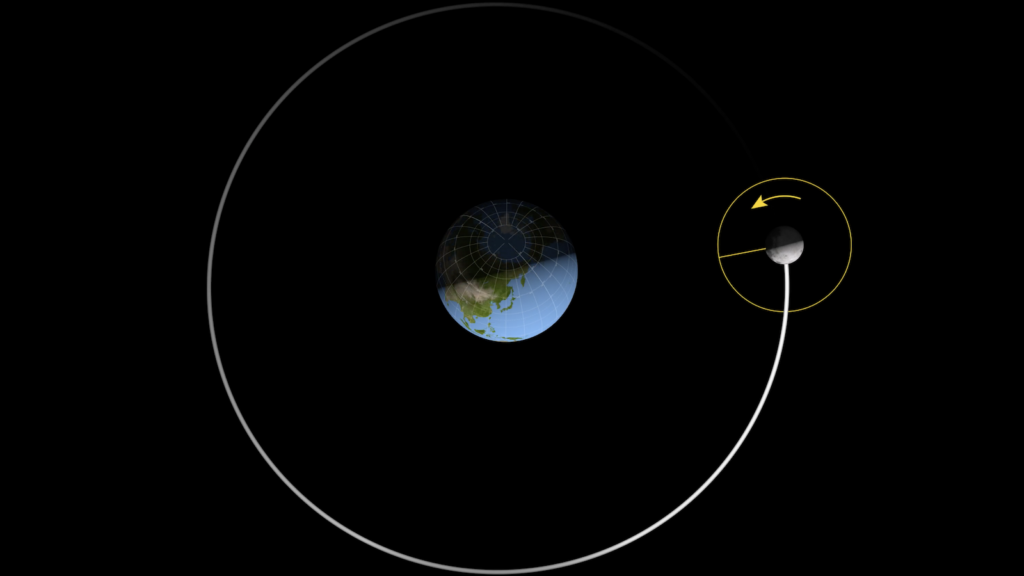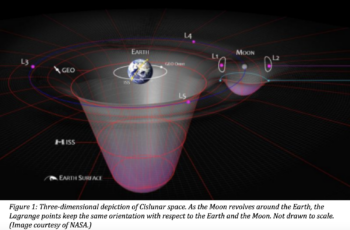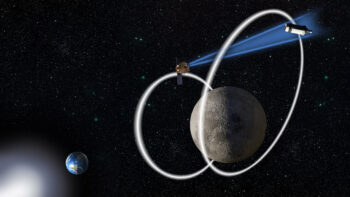
Cislunar space is the region beyond Earth’s orbit all the way out to the Moon. (Image: NASA)
WASHINGTON — A new White House strategy for interagency research on cislunar space activities includes all three of the Space Force’s own development priorities for operating in the vast region between the Earth’s orbit and that of the Moon: spacecraft and space junk monitoring, communications, and positioning, navigation and timing (PNT).
The National Cislunar Science and Technology Strategy [PDF], released today, represents a first US effort to build a whole-of-government strategy for “advancing scientific, exploration, and economic development activities” in cislunar space, the document explains, and supports the Biden administration’s 2021 Space Priorities Framework.
“The decade ahead is critically important for exploration of Cislunar space, including the Lunar surface,” the White House said in a fact sheet accompanying the strategy. “NASA estimates that over the next ten years, human activity in Cislunar space will be equal to or exceed all that has occurred in this region since the Space Age began in 1957.”
The strategy was put together by an interagency subcommittee of the Office of Technology and Policy’s National Science and Technology Council. That council is responsible for coordinating research across federal agencies and ensuring efforts are aimed at White House policy goals.
Members of the subcommittee included the Departments of Defense, Commerce (via the Office of Space Commerce), Energy, and State, as well as NASA, the National Science Foundation and the US Geological Survey. Participants from the executive branch included representatives of the National Security Council, the National Space Council, the Office of Management and Budget, and OSTP. It was chaired by OSTP Assistant Director Matthew Daniels.
 The subcommittee defines cislunar space as “the three-dimensional volume of space beyond Earth’s geosynchronous orbit that is mainly under the gravitational influence of the Earth and/or the Moon.” This includes the Earth-Moon Lagrange points, spacecraft trajectories for utilizing those regions, and the lunar surface, the document adds.
The subcommittee defines cislunar space as “the three-dimensional volume of space beyond Earth’s geosynchronous orbit that is mainly under the gravitational influence of the Earth and/or the Moon.” This includes the Earth-Moon Lagrange points, spacecraft trajectories for utilizing those regions, and the lunar surface, the document adds.
The Earth-Moon Lagrange points, the strategy explains, “are places in space where an object will keep the same position relative to the Earth and the Moon. The Earth-Moon system contains five Lagrange points (L1-L5). Spacecraft placed in the regions around Lagrange points will require little to no propulsion to maintain their position.”
As for the lunar surface, the document notes interest in particular in research for exploiting the unique properties of the far side of the Moon, what it calls the “shielded zone of the Moon (SZM).” That surface area, and orbits adjacent to it, by its nature is protected from radio frequency interference coming from Earth. “This area may enable radio astronomy observations that are not possible anywhere else,” the document notes.
The strategy includes four major objectives for future cislunar research efforts:
Enable long-term growth in cislunar space. “Research and development opportunities in Cislunar space range from novel discoveries in space science to the development of new Cislunar technologies to new breakthroughs in understanding the effects of the space environment on humans,” the document states.
Expand international science and technology cooperation. The document notes that international cooperation “can foster peace, develop responsible practices, and create the foundations for new institutions to enable enduring human and robotic presence” in cislunar space.
Implement communications and PNT capabilities. The document stresses the need for “scalable and interoperable approaches” that can help “foster new commercial development and lower barriers to entry while advancing responsible and safe spaceflight practices.” The strategy also pledges US government departments and agencies to leveraging and promoting “the use of commercial services” in cislunar space.
Extend US space situational awareness capabilities. “Space situational awareness is the necessary foundation to enable transparency and safe operations for all entities operating in Cislunar space. As activities in Cislunar space increase, the U.S. government will define requirements for new space situational awareness capabilities, including associated reference systems and data-sharing approaches. …This objective has synergies with efforts to provide early warning for potentially hazardous asteroids,” the document states.
The Space Force has been signaling interest in cislunar space domain awareness for several years, with the service in April formally initiating a new unit, called 19th Space Defense Squadron, to keep tabs on that region.

Artist’s rendering of the Air Force Research Laboratory’s Cislunar Highway Patrol demonstration satellite, now renamed Oracle. (AFRL Graphic)
The Air Force Research Laboratory (AFRL) further has been working on an effort to demonstration space object detection and tracking in the region of the Moon, with a prototype satellite project originally called the Cislunar Highway Patrol Satellite (CHPS). AFRL on Nov. 10 announced that the project has been renamed Oracle, after the ancient Greek soothsayer deity at Delphi, and that it has awarded a $72 million contract to Colorado startup Advanced Space LLC, and partners General Atomics, which provided the bus, and Leidos, which provided the optical payload. Advanced Space also operates NASA’s Cislunar Autonomous Positioning System Technology Operations and Navigation Experiment (CAPSTONE) experiment, based on a spacecraft provided by Terran Orbital, launched in June as part of the agency’s Artemis human space exploration program.
Space Force EW unit working to integrate new weapon systems, intel personnel
The Space Force’s Delta 3 is responsible for organizing, training and equipping Guardians for electronic warfare missions involving satellite communications, as well as sustaining related offensive and defensive EW systems.


























